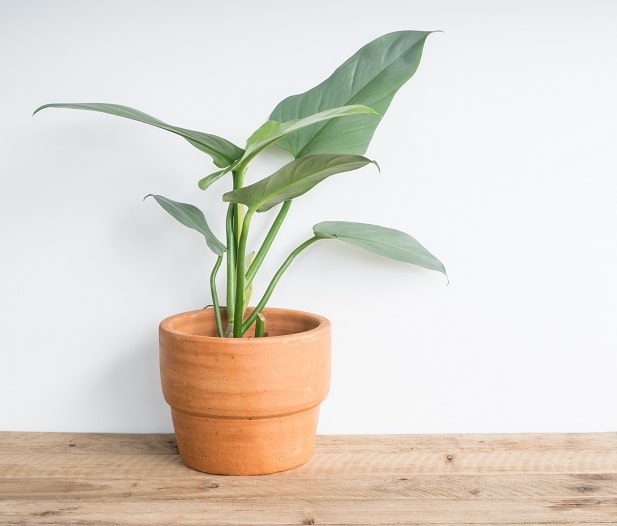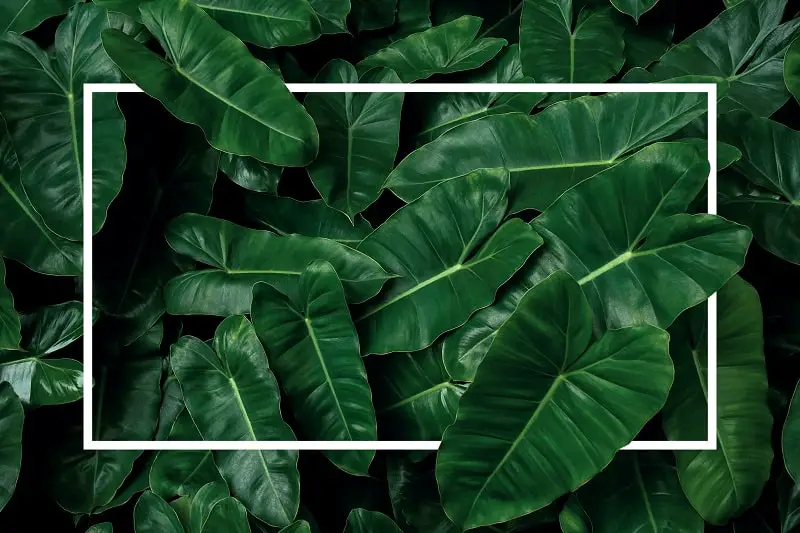The philodendron plant is an excellent houseplant that breathes new life into your house and working space. It displays a tropical look that makes your indoor space to stand out from others.
The indoor plant is forgiving and can tolerate all kinds of neglect. It could be one of the reasons behind their popularity in many American homes.
But philodendron plants do experience some issues. Curling leaves is the most common problem, and it can cause a lot of frustrations to the grower.
So, why are my philodendron leaves curling? This could be due to lack of water, temperature stress, nutritional deficiency, insect infestation, and soil type.
There is no need to freak since fixing the curling leaves is easy. This article provides detailed insights by explaining the causes and techniques for solving the issue.

You Might Also Enjoy: Pothos vs Philodendron Plants
Causes and Solutions of Philodendron Leaves Curling
Below are some of the popular causes and solutions for curling leaves on your philodendron houseplant:
Low Humidity
Philodendrons are tropical plants. This implies that the indoor plant thrives in an environment with high humidity. The condition promotes better growth and healthy foliage of the plant.
Low humidity surrounding is one of the reasons behind the philodendron micans leaves curling and yellowing. Failure to adjust to the environment will make the leaves start drooping.
How to Fix
- Mist the leaves of the plant regularly
- Use a pebble tray to increase humidity to the plant
- Use a humidifier to maintain humidity to the indoor plant
You May Also Enjoy: Do Philodendrons Like to Be Misted?
Temperature Stress
Temperature stress is a popular cause of silver philodendron leaves curling and drooping. High temperature increases the rate of transpiration. The indoor plant roots will be unable to cope up with the rate of water loss and this result in wilting and curling of leaves.
The philodendron plant is adaptable to different conditions. But the houseplant will not survive under low and high temperatures. Subjecting the plant to temperatures below 55°F (12°C) will facilitate drooping and its death.
How to Fix
- Ensure the room receives bright indirect sunlight
- Keep the houseplant away from any source of heat
- Ensure the soil is moist during winter to prevent wilting
- Purchase a thermometer to help maintain 60-80°F (15-26°C) indoor temperature during the day
Underwatering
Watering stress is the primary cause of leaves curling, yellowing and drooping. The issue is quite prevalent since many growers do not know how to water their philodendron houseplant.
Philodendron is a tropical plant. Research shows that the indoor plant thrives in an environment with adequate moisture and high humidity.
The houseplant will start displaying curl leaves when receiving insufficient water. You will also notice philodendron leaves drooping and turning brown.
How to Fix
- Put the plant in the sink without the saucer and fill it with water
- Allow the water to soak the plant via the drainage holes on the container
- Feel the topsoil with your finger to confirm if water has reached
- Water the philodendron from the top to ensure the water has saturated the soil
- Drain the sink and allow the soil to get rid of excess water
- Place the plant on its saucer and put it back to the right spot
Water Quality
All indoor plants need special water to foster better growth and healthy foliage. Distilled water is the most recommended since it contains fewer minerals that might ruin the well-being of the plant.
Tap water contains high minerals such as fluoride, chlorine, and salt. The buildup of the salt around the root system inhibits the absorption of water. The issue result in philodendron selloum leaves curling.
You should that poor water quality causes the leaves to curl and turn brown. The surface of the contained soil is seen with a white crust. Besides that, cold water shocks the growth of philodendron due to the development of root disease.
How to Fix
- Filter the water before watering. Filtration helps to eliminate fluoride and chlorine from water which prevents philodendron leaves from curling.
- Use lukewarm water since philodendron is a tropical plant. It helps to maintain the temperature and prevent emergency of root diseases.
You Can Also Read: How to Care for Philodendron Xanadu
Overwatering
Overwatering is another common philodendron problem. Many growers do not know how to water the philodendron plant. The issue is the possible cause of root diseases.
Damaged root system due to diseases inhibits intake of water from the soil. The plant will be unable to absorb adequate moisture and nutrients in the long run.
Philodendron plant will exhibit curling leaves and discoloration. Besides that, the potting soil will become smelly to indicate the presence of root rot.
How to Fix
- Repot the plant to another container with fresh soil. Ensure the container has drainage soil to get rid of excess water. Clean the roots and clip root hairs with brown spots.
- Inspect the root system thoroughly before repotting. Mushy roots imply that the philodendron plant cannot be revived.
- Learn to water the philodendron plant according to their schedule. We recommend checking the moisture content of the soil before watering.
Size of Pot
Philodendron is among the fast-growing houseplant. Some species grow between 3 to 8 feet and it is recommended to report the plant regularly.
Small pot usually makes the overgrown roots to experience a root-bound problem. The issue ends up inhibiting the proper intake of water and nutrients.
Larger pots will encourage overwatering and water may take longer to evaporate. The root-rot ends up destroying the houseplant.
How to Fix
- Repot the plant every year once it overgrows the current pot
- Ensure the new repotting container has drainage holes at the bottom

Type of Soil
Philodendron leaves curling and turning yellow could also be due to the soil type. The houseplant thrives in well-drained soil since there are minimal cases of waterlogging.
Permeable soil enhances root system aeration and intake of essential minerals and water. These nutrients foster better growth and healthy foliage.
Impermeable soil encourages waterlogging. The issue results in root-rot and this is responsible for the leave curling problem. Always check the type of soil before starting to consider growing the philodendron plant.
Plant Diseases
Philodendron plants are not resistant to any disease. The surroundings might make the indoor plant to contract the disease and leaves curling is one of the symptoms.
No need to freak since most philodendron diseases are curable. Inspect the plant to identify the type of plant disease. Fungal diseases usually cause powdery mildew on the leave surfaces.
How to Fix
- Regulate humidity levels (Too much humidity is responsible for the powdery mildew on the leaves.)
- Put the plant in an area that has proper air ventilation
- Try to avoid overwatering
- Discard the plant to avoid spreading the disease to other houseplants
You May Also Like: Why Are My Pothos Leaves Turning Yellow?
Insect Infestation
Philodendron plants are highly susceptible to insect infestations. Aphids and thrips are the common types of insects that attack the houseplant.
These creatures are known for sucking nutrients from the leaves and this results in curling. Plant leaves become droopy, turn yellow, and fall after some days.
How to Fix
- Apply non-toxic soap solution on the plant leaves to kill the insects
- Prune and discard the leaves infested by insects
- Spray the plant with a systemic insecticide to kill the insects
Lack of Nutrition
Lack of nutrients in the soil increases the pH level. The condition makes the root systems to absorb vital nutrients that support plant growth and healthy foliage.
Philodendron leaves curling can be caused by nitrogen deficiencies in the soil. The houseplant will be unable to undertake photosynthesis. The issue might also cause stunted growth and leave discoloration.
Phosphorus deficiencies cause also philodendron leaves to curl and turn yellow. The leaves might also experience the formation of brown spots.
How to Fix
- Ensure the soil pH is about 4.5-6.0. Get a pH tester from the market to help maintain a proper soil pH.
- Use compost to supply the plant with nutrients and moisture. It also helps to avoid the emergence of diseases.
- Fertilize philodendrons plants that exhibit stunted growth. We recommend urea or ammonium sulfate due to the presence of nitrogen and phosphorus.
Light Stress
Philodendron plants thrive under shade or areas that receive bright indirect sunlight. The light facilitates the breakdown of water during photosynthesis.
Too much light exposure cause dehydration of the plant. Philodendron plant experiences leave curling and drooping due to dehydration.
Keep in mind limited light exposure make philodendron plant to experience unhealthy foliage and leggy stems. This type of environment also causes stunted growth.
How to Fix
- Place the plant in a spot it receives bright indirect sunlight
- Dust the leaves to allow effective sunlight exposure
- Rehydrate the plant by watering to avoid wilting and curling leaves
Over-Fertilization
Too much fertilizer application is another crucial factor that makes philodendron leaves to curl and turn brown. The buildup of excess salt around the roots inhibits the intake of water and this causes a lot of damages.
Besides that, over-fertilization increases the risk of the plant to contract diseases and insect infestations. These factors as seen earlier also cause curling and yellow of leaves.
How to Fix
- Repot the plant if you have over-fertilized the pot
- Always apply fertilizer during the spring and autumn season
- Check the soil nutrients before applying fertilizer
- Use compost, bone meal emulsion, and manures instead of artificial fertilizers

In Conclusion
Philodendron leaves curling could be due to low humidity, high temperature, lack of nutrients, lack of water, root-rot and light stress. Keep these factors checked will help to prevent philodendron leaves from curling and yellowing or browning.
Most measures outlined in the article have been tested and proven to be effective. We recommend inspecting the source of the problem to your houseplant before implementing the techniques.
Keep in mind that philodendron problems are curable and inevitable. Do not freak since caring for philodendron plants is super easy.
You Might Also Like: Why Is My Alocasia Polly Dying?
